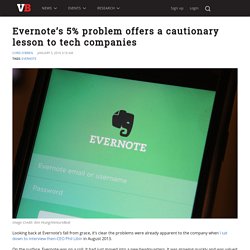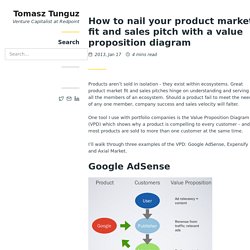

Evernote's 5% problem offers a cautionary lesson to tech companies. Looking back at Evernote’s fall from grace, it’s clear the problems were already apparent to the company when I sat down to interview then-CEO Phil Libin in August 2013.

On the surface, Evernote was on a roll. It had just moved into a new headquarters. It was growing quickly and was valued at $1 billion. And it seemed to be loved by its users. I used it (and still do). Still, the conversation was mostly upbeat, with Libin talking about his vision for building a company that would last 100 years. We were talking about how Evernote was often lumped in with other companies (Dropbox, Box) that let you share and store files online. He conceded that Evernote had so many features, in fact, that it could sometimes be difficult to explain to newcomers exactly what Evernote was: Evernote had spread itself too thin, and there was no core experience. But the 5 percent problem offers a good lesson about how important it is to maintain a core identity as you build new features and products. How to nail your product market fit and sales pitch with a value proposition diagram.
Products aren’t sold in isolation - they exist within ecosystems.

Great product market fit and sales pitches hinge on understanding and serving all the members of an ecosystem. Should a product fail to meet the needs of any one member, company success and sales velocity will falter. One tool I use with portfolio companies is the Value Proposition Diagram (VPD) which shows why a product is compelling to every customer - and most products are sold to more than one customer at the same time. I’ll walk through three examples of the VPD: Google AdSense, Expensify and Axial Market. A VPD has three columns: the product, the customers and the value proposition for each customer. Google’s AdSense enables publishers to run ads on their websites to generate revenue.
The user is the most important. The advertiser follows the user in importance. That’s the genius of AdSense: ad relevancy aligns the incentives of everyone in the ecosystem. Expensify builds expense management systems for SMBs. Are You Building The Right Product? Editor’s note: Guest contributor Eric Ries is a consultant and the author of The Lean Startup, which he will be launching at Disrupt SF on Tuesday.

Follow him @ericries. I was recently asked to spend some time with an early stage startup that has a revolutionary new product. I asked them if they thought they were making their product better. As with every other startup I’ve asked, they said yes. Then I asked them, “How do you know?” Then I asked them this question: what would happen to the company if the entire product development team took a month off and went on vacation?
In one scenario, they’ve been working overtime, putting in crazy hours, and in the other, they’d be on vacation. Most product teams don’t know if they are making their product better or worse; that’s why customers feel a twinge of fear every time they have to update or upgrade. We divided our customers into cohorts, looking at the new customers who joined each day as a distinct group. Products are really experiments. Preaching User-Driven Design. Do Things that Don't Scale. July 2013 One of the most common types of advice we give at Y Combinator is to do things that don't scale.

A lot of would-be founders believe that startups either take off or don't. You build something, make it available, and if you've made a better mousetrap, people beat a path to your door as promised. Or they don't, in which case the market must not exist. [1] Actually startups take off because the founders make them take off. Recruit The most common unscalable thing founders have to do at the start is to recruit users manually. Stripe is one of the most successful startups we've funded, and the problem they solved was an urgent one. Startups building things for other startups have a big pool of potential users in the other companies we've funded, and none took better advantage of it than Stripe. There are two reasons founders resist going out and recruiting users individually. The other reason founders ignore this path is that the absolute numbers seem so small at first.
Fragile Fire.